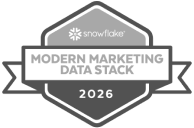Why AI fails without strong governance
Let’s zoom out for a second.
For years, data governance was treated as a formality. It was manual, bureaucratic, and often siloed within legal or compliance teams. It felt like overhead. It slowed things down. And because it didn’t tie clearly to business outcomes, it was easy to push off.
But with the rise of AI and modern analytics, that mindset no longer works.
Today, if your data is incomplete, undocumented, or unreliable, everything else falls apart. Dashboards break. Models fail. AI systems hallucinate or perpetuate bias. And as executive pressure grows to deliver quick wins from AI, many data teams are left trying to build on shaky foundations.
Generative AI may have captured mindshare, but when it comes to budgets, data infrastructure still leads. According to IDC, organizations are prioritizing foundational systems over models because without that groundwork, nothing performs.
That’s where the AI Readiness Framework comes in.
The four pillars of AI-ready data
To be ready for AI, your data needs more than basic collection. It needs governance. That means building on four foundational pillars: Reliable, Accurate, Usable, and Secure. These are the core areas to strengthen before generative AI can drive meaningful business outcomes.
Reliable
AI depends on data you can trust. That requires systems and signals that ensure consistency across your pipelines:
- Freshness monitoring that checks whether data is current
- Automated lineage that maps how data flows across systems
- Column- and table-level traceability to understand the downstream impact of changes
- Automated metadata management and cataloging to keep documentation accurate and up to date
You cannot achieve this level of reliability with manual updates or static documentation. It needs to be integrated into your tooling and maintained automatically.

Accurate
The quality of the data you feed into AI models directly influences the results they produce. Accuracy starts with:
- Validation pipelines that enforce checks during ingestion and transformation
- Profiling tools that identify null values, duplicates, schema mismatches, and outliers
- Standard quality metrics like completeness, consistency, and timeliness
Tools like Secoda Monitors and dbt help teams not only catch issues but stop incorrect data before it reaches production. Real-time alerts make it possible to take action as soon as problems appear, especially when data shifts silently behind the scenes.

Usable
Even the most accurate dataset is useless if no one can interpret it. Usability is about giving people (and AI systems) the context they need:
- Clear documentation at the table and column level
- Assigned ownership so people know who to go to with questions
- Tags and business glossaries that connect technical assets to business concepts
- A system of question-and-answer history that captures tribal knowledge and past decisions
Metadata should be treated as active infrastructure, not passive documentation. Start by enriching the data that supports your highest-value use cases. Broader standardization can follow once you’ve shown clear value.

Secure
AI adds new urgency to existing concerns around data privacy and compliance. Getting this right means embedding security directly into how your data is managed:
- Custom roles and RBAC to control who can access what
- Approval workflows that connect to your identity systems
- Tagging and masking of sensitive fields like PII or financial data
- Governance policies enforced as part of your data pipelines, not manual reviews
Security needs to be part of the system from the start. Anonymization, audit trails, and access controls should support velocity, not slow it down.

Checklist: How to evaluate your team’s readiness
AI readiness starts with a clear-eyed look at your data foundation. Use this checklist to evaluate your team’s progress across the four pillars.
✅ Reliability indicators
Is your data consistently trustworthy?
- Freshness monitors are configured and passing
- Teams can quickly trace dependencies upstream and downstream at both the table and column level
- Metadata is automatically captured and updated
If reliability is weak, it becomes difficult to trust that the data feeding your AI models reflects reality.
✅ Accuracy indicators
Can you prove your data is correct?
- Automated tests flag issues like nulls, duplicates, and schema mismatches
- Alerts notify teams when something breaks
- Data validation is integrated into pipelines using tools like dbt or Great Expectations
Without built-in validation, errors can silently shape model behavior and go unnoticed until the damage is already done.
✅ Usability indicators
Can your team (and your AI systems) understand the data?
- Each dataset is clearly described with business context
- Individual columns are documented so people know what they represent
- Ownership is assigned and visible on core datasets
- Assets are tagged to indicate what kind of data they contain (e.g., PII, verified, test)
- Historical context is tied to assets, like glossary terms or past Q&A
- Catalog is easily searchable by technical and non-technical users
- Documentation is accessible in the tools teams already use, like Slack and BI
Even the cleanest data is unusable if people can’t understand it or find what they need.
✅ Security indicators
Is your data properly protected and access-controlled?
- Access is governed by RBAC and custom roles that align with user responsibilities
- Users can request data access through a process that is logged, reviewed, and auditable
- Sensitive data is clearly flagged and automatically masked where appropriate
- Compliance requirements such as GDPR and HIPAA are built into day-to-day workflows
- All changes to data and access are versioned, logged, and revertible if needed
Strong governance doesn’t just safeguard your data. It empowers your teams to move quickly without taking on unnecessary risk.

The more checks you can confidently mark, the closer you are to true AI readiness.
Recommendations: What to prioritize first
When preparing your data for AI adoption, it’s tempting to jump straight into model development. But without a strong foundation, even the best models won’t deliver results.
Here’s a phased approach to help you focus on the right work early on, starting with governance that actually supports AI.
Step 1: Centralize metadata and ownership
You can’t govern what you can’t see. Start by bringing your documentation, tags, owners, and glossary terms into one unified catalog. This gives you visibility into what data exists and who’s responsible for it.
Focus first on high-impact datasets powering key models and dashboards. Assign ownership where it’s missing, and apply business-relevant tags. Use automation to avoid making metadata upkeep another manual task.
Instead of creating a new layer of governance roles, embed ownership within existing teams. This keeps things moving and makes adoption easier.
Step 2: Automate lineage and impact analysis
Choose tools that automatically capture lineage from ingestion through transformation to model training. Lineage should cover both table and column level dependencies, without requiring manual input.
This becomes especially important during model updates, retraining, or debugging. You need to know what changed, where it came from, and what it might affect.
Step 3: Build in access control and policy enforcement
Governance isn’t just about limiting access. It’s about enabling safe, secure collaboration. That starts with clearly defined roles, streamlined approvals, and sensitive data tagging.
Policies should be codified in your workflows, not added manually after the fact. For teams in regulated industries, consider anonymization and synthetic data approaches that preserve privacy while maintaining utility.
Step 4: Set up automated validation and monitoring
Build proactive data quality workflows. Start with lightweight validation rules on high-value datasets, then expand to cover drift and schema changes over time. Connect alerts to Slack or Teams so your team can act fast when issues arise.
Step 5: Make governance easy to adopt
Governance only works if people actually use it. Provide teams with automation, templates, and helpful defaults instead of review boards and approval queues. Build guardrails into the systems they already use.
Think of it as governance-as-a-service. It should guide people without getting in their way.
Step 6: Introduce AI gradually
Once the groundwork is in place, you can begin layering in AI use cases with confidence. That might include semantic search across your catalog, using AI to generate documentation, or deploying lightweight models for internal tasks.
Start where value is clear and the risks are low. A strong foundation means each new use case is easier to support and scale.
Scale governance with Secoda AI
Once the right systems are in place, the next challenge is scale. That’s where Secoda AI helps.
Secoda AI is like having a data analyst available 24/7—one who knows your data’s lineage, documentation, semantic layer, and quality status. Anyone can ask questions in plain language and get answers backed by context, not guesswork. It writes and executes SQL, pulls from your catalog and monitors, and explains how the data works.
For data teams, it means fewer repetitive requests, fewer one-off Slack messages, and less time spent tracking down owners, definitions, or upstream impacts. For business users, it means getting answers themselves faster and more accurately, without creating new bottlenecks.
With Secoda AI, you can:
- Let anyone ask questions and get trusted answers using the context of your metadata, lineage, and documentation
- Automatically surface gaps in data quality or governance without hunting through multiple tools
- Write and run SQL with natural language prompts, reducing dependency on engineering resources
- Build trust by showing exactly how answers were derived, with full visibility into query logic and errors
- Enforce access permissions and governance rules behind the scenes, keeping sensitive data secure
Secoda AI makes governance feel less like a chore and more like a built-in productivity tool. It helps teams move faster, with better data, and prepares the entire organization for AI adoption on your terms.
One score that shows you're AI-ready
Secoda’s Data Quality Score (DQS) brings the AI Readiness Framework to life. It breaks down your data assets across the four key pillars and gives you a single, actionable score.
You don’t have to guess where to start. Secoda shows you exactly what to improve, and helps you track progress as your data becomes more trustworthy, better documented, and AI-ready.
With automated suggestions and real-time scoring, DQS helps teams:
- Identify weak points across their data assets
- Take guided steps to improve documentation, ownership, and quality
- Monitor progress toward a clean, trusted data foundation
- Know when their data is actually ready to support AI

Why you need one governance platform, not five disconnected tools
Trying to manage governance across multiple point solutions creates more problems than it solves. It leads to:
- Duplicate work maintaining metadata across catalogs and wikis
- Delays in access approvals due to fragmented request systems
- Blind spots in lineage when tools don’t talk to each other
- Inconsistent policy enforcement that breaks down at scale
All of this slows teams down and creates friction that prevents AI from delivering results.
Secoda solves this by bringing everything into one platform, purpose-built for modern data teams that want to move quickly while staying compliant.
With Secoda, your team gets:
- Automated metadata management and a search-first catalog so documentation stays fresh and accessible, right where people need it
- End-to-end lineage tracking at the table and column level, automatically updated as your data changes
- Built-in quality monitoring through Secoda Monitors, with real-time alerts and scoring across reliability, accuracy, usability, and stewardship
- Validation checks that connect with tools like dbt, Monte Carlo, and Great Expectations to give you a full picture of data health
- Secoda AI, a built-in chatbot that draws on metadata, lineage, and documentation to provide accurate, context-aware answers. It allows any user to ask questions about data in plain language and go back and forth for discovery.
- Role-based access control (RBAC) and approval workflows, giving teams visibility, security, and auditability in how data is accessed
- Policy enforcement
- built directly into your pipelines, with customizable governance rules that flag non-compliant resources, send alerts, and trigger remediation steps automatically
- Prebuilt frameworks like SOC 2, GDPR, and HIPAA that make it easy to implement policies without starting from scratch
- AI-powered automation and search, making it easy to find answers, generate documentation, and work more efficiently
- Integrated glossary and tagging, helping teams align on shared definitions while staying focused on high-value AI use cases
- Slack, Teams, browser extensions, and BI tool integrations, so governance shows up inside the workflows your team already uses
- Secoda’s Data Quality Score, which measures your data against the four pillars of AI readiness and provides actionable suggestions for improving each asset until it meets the standard for high quality data
Instead of stitching together five tools and hoping they stay in sync, Secoda gives you one place to manage everything. It’s fast to implement, easy to maintain, and flexible enough to support any stage of your AI journey.
Final thoughts
Governance is no longer just about compliance. It is the foundation for analytics, self-serve reporting, machine learning, and trusted AI.
While the AI market continues to grow, most organizations are still catching up. The biggest blockers are not talent gaps or model performance. They are upstream in the data.
Investing early in governance, metadata, quality, and infrastructure reduces risk, speeds up AI initiatives, and builds trust in outcomes. It also gives your data team the clarity and tools they need to deliver results on their own timeline, not just the executive’s.
If you’re ready to build a real foundation for AI, book a demo and see what Secoda can do.






.png)
.png)








